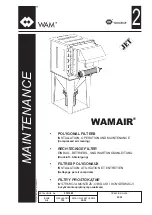
7
ArrestAll
© 2015 American Air Filter Company, Inc. Any use of the text or images
this document contains, without permission of American Air Filter
Company, Inc., is prohibited. ArrestAll, AAF, REDClean, REDFiltration,
and Reliable Efficient Durable are registered trademarks of American Air
Filter Company, Inc. d/b/a AAF International.
for the prevention of explosions by means of various methods. The user shall be
fully conversant with the provisions of NFPA 69 and shall comply in full with all of
its requirements.
By its very nature AAF equipment is intended to be used to capture airborne
particulate matter, otherwise known as dust. There are various methods for
dealing with a dust explosion in a dust collector. These can include, but are not
limited to, the use of properly designed explosion vents, explosion suppression
systems, or flameless vents. The user shall understand which method is being
used and who is responsible for the design and supply of the equipment required.
When an explosive dust has been properly identified to AAF, the dust collector may
be structurally designed to withstand the internal pressure generated during the
explosive event and fitted with an explosion vent, or with multiple vents, designed
to safely discharge the pressure and the resulting fireball. The user shall review
the purchase order and the documents referenced within it to determine if
explosion protection equipment has been supplied by AAF International. Where
this is the case, review the appropriate sections of this manual that deal with the
installation, operation and maintenance of the equipment ordered.
When explosion protection systems are supplied by multiple vendors, it is
the responsibility of the user to coordinate between suppliers to ensure that the
equipment supplied by each vendor will work together to achieve the required
protection. For instance, if an explosion suppression system is being supplied by
parties other than AAF, it is incumbent on the user to ensure that the dust
collection equipment has been ordered to resist the internal pressure defined by
the suppression equipment supplier.
Dust collectors fitted with explosion vents must not be located indoors, unless
properly designed in accordance to NFPA regulations. The equipment shall be
oriented so that the vent will discharge to an unoccupied zone. Such a zone will be
prohibited to personnel and shall not include critical equipment or services such as
fuel storage tanks, flammable materials, fire hydrants, power distribution or
electrical control equipment, or similar. If the vent(s) is located on the side(s) of
the equipment the vent discharge area shall be isolated with barriers erected to
prevent the parking of vehicles, pedestrian use, or use of the area for temporary
storage. Warning signs shall be posted. Include diagrams showing the distribution
of a typical dust explosion discharge.





























